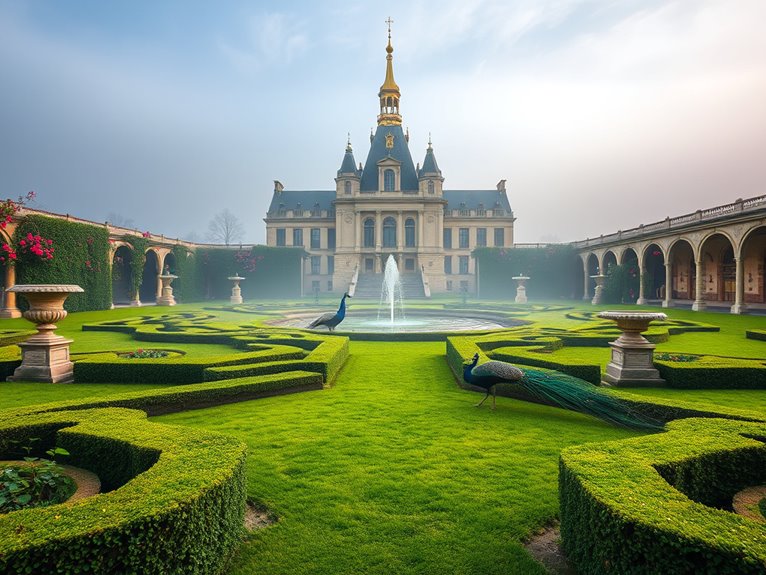
6 Charming Day Trips From Paris Within One Hour
I'll take you on six incredible day trips, all within an hour of Paris! Visit Versailles' opulent Hall of Mirrors, wander through Monet's dreamy gardens at Giverny, or explore Fontainebleau's majestic castle and forest. Don't miss Chantilly's legendary cream and equestrian shows, Saint-Germain-en-Laye's medieval charm, or Senlis' preserved ancient streets. Each destination offers unique experiences, from royal palaces to artistic havens – and the best part? They're all perfect for escaping the city's hustle! Let's discover what makes each spot truly special.
Versailles: A Royal Escape to the Sun King's Palace
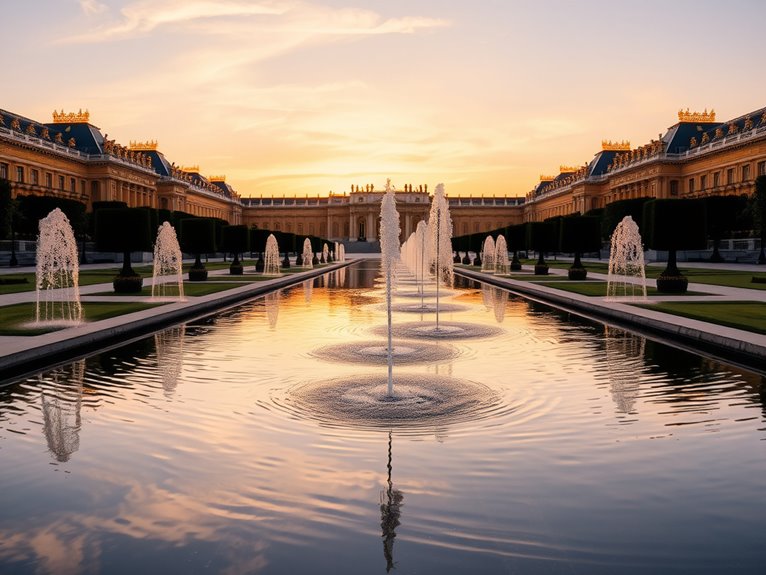
The Palace of Versailles stands as the ultimate symbol of French royal opulence, a magnificent representation of the grandeur of Louis XIV, the Sun King. This UNESCO World Heritage site, just 12 miles southwest of Paris, transforms a simple day trip into an extraordinary journey through French history, architecture, and artistry, where every gilded room and manicured garden tells stories of power, intrigue, and unprecedented luxury.
Walking through Versailles is like stepping into a living museum where the French monarchy's most dramatic chapters unfolded. From the dazzling Hall of Mirrors to Marie Antoinette's private estate, visitors can explore 2,300 rooms spread across 721,182 square feet of royal architecture, complemented by nearly 2,000 acres of precisely landscaped gardens that showcase the pinnacle of French formal garden design.
Quick Facts:
- Opening Hours: 9:00 AM – 5:30 PM (closed Mondays)
- Best Time to Visit: Tuesday and Wednesday mornings
- Ticket Prices: €18-27 (palace), €8-10 (gardens), €20-27 (passport with full access)
- Photography: Allowed without flash inside; tripods permitted in gardens only
- Accessibility: Wheelchair accessible with dedicated routes
- Average Visit Duration: 4-6 hours for full experience
- Distance from Paris: 30-40 minutes by RER C train
Hall of Mirrors (Galerie des Glaces)
The palace's most famous gallery features 357 mirrors reflecting 17 arch windows and crystal chandeliers, creating an infinite play of light and reflection. This 73-meter-long hall hosted royal ceremonies and remains the most photographed spot in Versailles. Insider tip: Visit during the last hour before closing when tour groups have departed for the best mirror selfies without crowds.
Royal Gardens
Designed by André Le Nôtre, these symmetrical gardens feature elaborate fountains, sculpture-lined paths, and hidden groves. The Musical Fountain Shows (April-October) bring the gardens to life with baroque music and synchronized water displays. Pay special attention to the Latona Fountain, recently restored to its original glory with 24-karat gold leaf details.
Marie Antoinette's Estate
This separate area includes the Petit Trianon palace and the charming Queen's Hamlet, where Marie Antoinette escaped court life. Lesser-known fact: The working farm still maintains period-accurate livestock breeds and produces honey sold in the palace shop.
Pro Tips:
Skip the main entrance crowds by entering through the Grille de la Reine gate near the Petit Trianon. Purchase a timed-entry ticket online and arrive 30 minutes before your slot. The gardens are free to visit on Wednesdays and Thursdays except during Musical Fountain Shows. Consider visiting during winter months when crowds thin notably and the frost-covered gardens offer unique photo opportunities.
Practical Advice:
Wear comfortable walking shoes as the marble floors and extensive gardens demand considerable walking. Pack a picnic to enjoy in the gardens (permitted except during special events) and bring a water bottle – fountains throughout the grounds provide drinking water. Download the official Palace of Versailles app before arriving for free audio tours and real-time crowd monitoring of different palace sections. If visiting between March and October, book tickets for the Musical Fountain Shows in advance as they frequently sell out.
Giverny: Monet's Garden Paradise
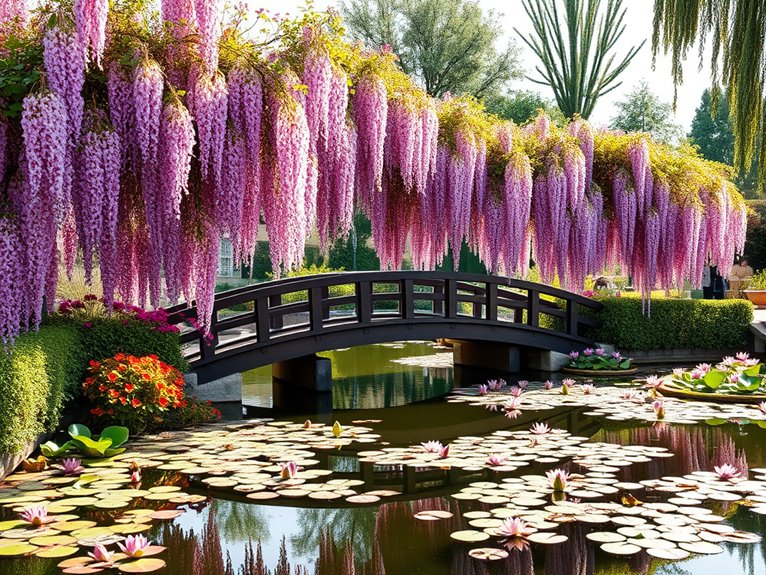
Nestled in the picturesque Norman countryside just 75 kilometers from Paris, Giverny stands as a living canvas that inspired some of Claude Monet's most celebrated masterpieces. This enchanting village, anchored by the artist's meticulously restored home and gardens, offers visitors a rare opportunity to step directly into the world that gave birth to Impressionism's most iconic water lily paintings and vibrant floral scenes.
The gardens at Giverny unfold in two distinct yet harmonious spaces: the flower-filled Clos Normand in front of Monet's pink and green house, and the mesmerizing water garden with its legendary Japanese bridge and lily ponds. Throughout the seasons, these gardens transform with ever-changing colors and blooms, making each visit a unique experience that captures the same magical light and atmosphere that captivated Monet for over 40 years.
Quick Facts:
- Best visiting times: April to October, Tuesday-Sunday, 9:30 AM-6:00 PM
- Admission: €13 adults, free for children under 7
- Photography allowed (no tripods or selfie sticks)
- Peak blooming seasons: Spring (April-May) for tulips and irises; Summer (June-August) for water lilies
- Advance booking highly recommended during peak season
- Accessible by train from Paris Saint-Lazare station (45 minutes)
The Clos Normand Garden
The front garden showcases Monet's passion for color and perspective, with flower beds arranged in stunning geometrical patterns. Seasonal blooms include daffodils, tulips, irises, peonies, and roses, creating ever-changing tapestries of color. The garden's design allows visitors to wander through narrow alleys while admiring the artistic composition from various angles. Insider tip: Visit in late afternoon when the setting sun illuminates the flowers from behind, creating the ethereal light effects Monet sought to capture.
The Water Garden
Across the road lies the famous water garden, inspired by Japanese aesthetics and home to the iconic green Japanese bridges and water lily ponds. The reflecting pool, framed by weeping willows and bamboo groves, mirrors the sky and surrounding vegetation exactly as depicted in Monet's paintings. Lesser-known feature: Hidden benches around the pond's perimeter offer quiet spots for contemplation away from the main crowd.
Monet's House
The restored pink and green house provides intimate insights into the artist's daily life. The bright yellow dining room and blue kitchen, preserved with original furnishings, showcase Monet's bold use of color in his personal space. Special access: The second-floor windows offer rarely photographed views of the gardens from Monet's perspective.
Pro Tips:
To truly experience Giverny like an insider, arrive when the gardens open at 9:30 AM. Early morning visitors can capture the gardens in perfect light conditions and enjoy relatively crowd-free paths. Consider visiting twice in one day – morning for photography and atmosphere, late afternoon for the changing light conditions. Most tour buses arrive mid-day, making these times particularly peaceful.
Practical Advice:
Book tickets online in advance and consider combining your visit with a local lunch reservation in the village. The gardens can be muddy after rain, so wear appropriate footwear. Bring a small sketchpad or watercolors – many quiet corners provide perfect spots for artistic inspiration. For photographers, overcast days often provide the best conditions for capturing the subtle colors of the water lilies and avoiding harsh shadows in the flower gardens.
Fontainebleau: Forest Adventures and Castle Grandeur
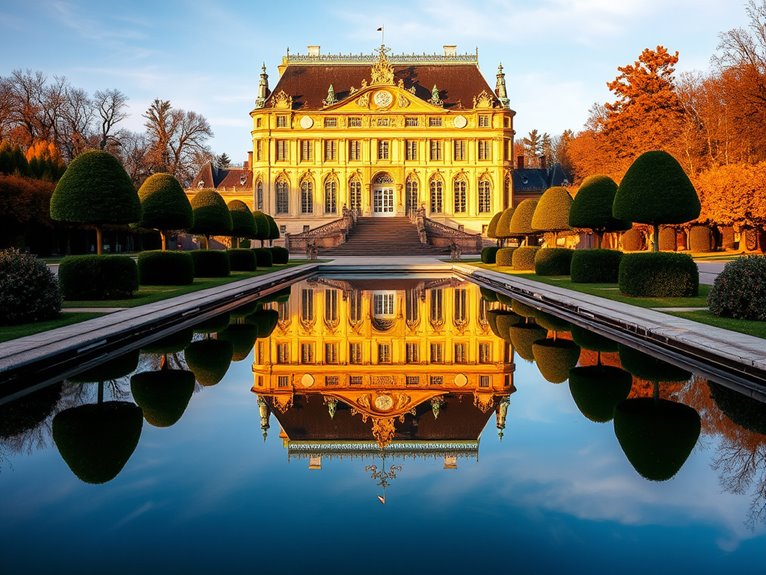
Charming Day Trips From Paris: Fontainebleau
Forest Adventures and Castle Grandeur
Just 55.5 kilometers southeast of Paris lies the magnificent Château de Fontainebleau, a UNESCO World Heritage site that served as a royal residence for over seven centuries. This stunning palace, surrounded by one of France's largest forests, offers visitors an authentic glimpse into French royal life without the overwhelming crowds often found at Versailles. The château's 1,500 rooms and 130 acres of gardens represent every period of French architecture from the 12th to the 19th century.
The surrounding Fontainebleau Forest is equally impressive, boasting 25,000 hectares of diverse landscapes, including dramatic rock formations that make it a world-renowned destination for boulder climbing (bouldering). Whether you're interested in royal history, outdoor adventures, or both, Fontainebleau provides an perfect escape from the bustle of Paris, combining cultural richness with natural beauty.
Quick Facts:
- Best visiting time: March to October; weekdays are less crowded
- Castle admission: €13 for adults, free for EU residents under 26
- Opening hours: 9:30 AM – 5:00 PM (closed Tuesdays)
- Photography: Allowed without flash inside the château
- Accessibility: Most castle areas wheelchair accessible
- Forest access: Free, year-round
- Climbing season: Spring and Fall are ideal
Château de Fontainebleau:
The palace interior showcases opulent state apartments, including Napoleon's throne room and Marie Antoinette's boudoir. The famous horseshoe-shaped staircase, where Napoleon bid farewell to his guards before his exile, remains one of the château's most photographed features. Insider tip: Book a guided tour of the private apartments, which are only accessible with a guide and offer intimate glimpses into royal daily life.
Forest Exploration:
The forest features over 300 kilometers of marked hiking trails and thousands of boulder problems for climbers of all levels. The most popular climbing areas are Trois Pignons and Bas Cuvier. The forest also houses rare flora and fauna, making it perfect for nature photography and bird watching. Insider tip: Visit the "Elephant" boulder formation at sunset for spectacular photo opportunities and fewer climbers.
Gardens and Parks:
The château's gardens represent various styles, from André Le Nôtre's formal French gardens to the English-style garden with its romantic canal. The Carp Pond, dating back to Henri IV's reign, offers boat rentals in summer. Insider tip: The less-visited Diana's Garden on the château's north side provides peaceful spots for picnics away from tourist groups.
Pro Tips:
Combine your visit with the local market days (Tuesday, Friday, and Sunday mornings) in Fontainebleau town for an authentic French experience. For photographers, early morning light creates magical effects on the château's facade, while the forest's golden hour occurs around 4-5 PM in winter and 7-8 PM in summer. Consider renting a bike in town to explore both the forest and palace grounds more efficiently.
Practical Advice:
Transportation from Paris is straightforward via train from Gare de Lyon to Fontainebleau-Avon station (40 minutes), followed by the "Ligne 1" bus to the château. Purchase a combined train-bus ticket at any Paris station. For climbers, rental shops in town provide crash pads and equipment, but advance reservations are recommended during peak season. Pack comfortable walking shoes, as the historic cobblestones and forest trails can be challenging in inappropriate footwear.
Chantilly: Cream, Castles, and Equestrian Excellence
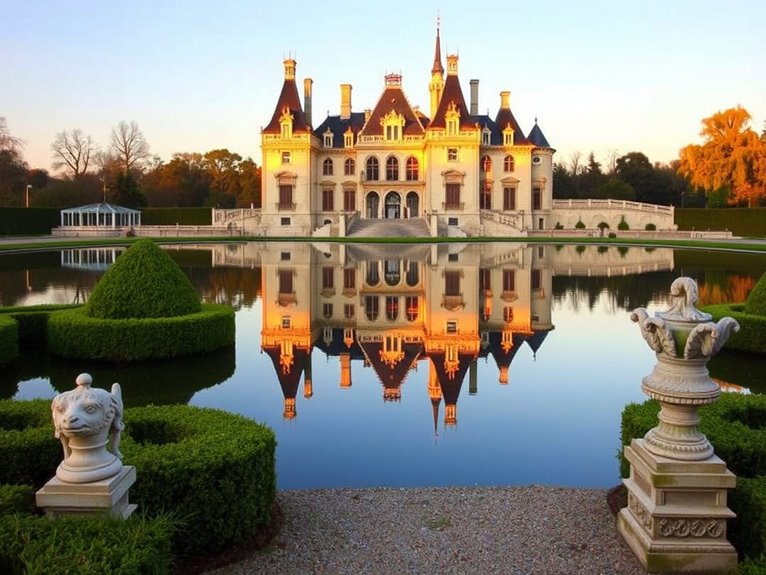
Just 30 miles north of Paris lies Chantilly, a magnificent showcase of French aristocratic grandeur and cultural refinement. The town's crown jewel, the Château de Chantilly, rises from its reflection in surrounding waters like a fairytale castle, while the legendary Grandes Écuries (Great Stables) stands as the world's largest princely stable, showcasing France's centuries-old equestrian tradition.
Beyond its architectural splendors, Chantilly has gifted the culinary world with its namesake whipped cream (Crème Chantilly) and houses the second-largest collection of antique paintings in France after the Louvre. This guide explores the essential experiences in this historic town, from touring opulent chambers to witnessing spectacular horse shows and indulging in cream-topped delicacies.
Quick Facts:
- Best visiting time: April-October, Tuesday-Sunday (closed Mondays)
- Castle admission: €17-21 (includes gardens and stables)
- Photography: Allowed without flash in most areas
- Train from Paris: 25 minutes from Gare du Nord
- Language: Audio guides available in multiple languages
- Accessibility: Most areas wheelchair accessible
- Restaurant reservations: Recommended for weekends
- Weather consideration: Gardens best in spring/summer
Château de Chantilly
The château houses the Condé Museum's remarkable art collection, including works by Raphael and Botticelli. The stunning French-style gardens, designed by Le Nôtre (who also designed Versailles), feature spectacular water features and geometric patterns. Open 10:00-18:00 (March-October) and 10:30-17:00 (November-February). Insider tip: Visit the private apartments during the last tour of the day when crowds thin out, and ask about the hidden message in the Gallery of Actions of the Great Condé.
The Great Stables
The magnificent 18th-century stables host daily equestrian shows showcasing classical dressage. The Living Museum of the Horse within offers fascinating insights into equine history. Shows at 14:30 and 16:30 daily (additional fee). Insider tip: Book the morning training session viewing (8:30-10:00) to see riders practice without crowds and get unique photo opportunities.
Crème Chantilly Experience
Visit La Capitainerie restaurant in the château grounds to taste authentic Crème Chantilly, whipped fresh to order. Cooking demonstrations available by appointment. Insider tip: The kitchen still uses the original 17th-century recipe; request a behind-the-scenes peek at the traditional preparation method.
Pro Tips
Time your visit to catch both the morning castle opening and afternoon horse show by arriving at 9:45 AM. Purchase the combined ticket for best value, and consider the guided garden tour (available in English at 11:30) to understand the intricate symbolism in Le Nôtre's design. Photographers should position themselves at the grand reflecting pool during golden hour for stunning château reflections.
Practical Advice
While Chantilly is accessible year-round, weekday visits offer a more relaxed experience. Comfortable walking shoes are essential as the estate is extensive. Consider purchasing tickets online to avoid queues, and download the château's app for self-guided tours. The last direct train to Paris typically departs around 22:30, but check SNCF schedules as timing varies seasonally.
Saint-Germain-en-Laye: Medieval Charm Meets Royal History
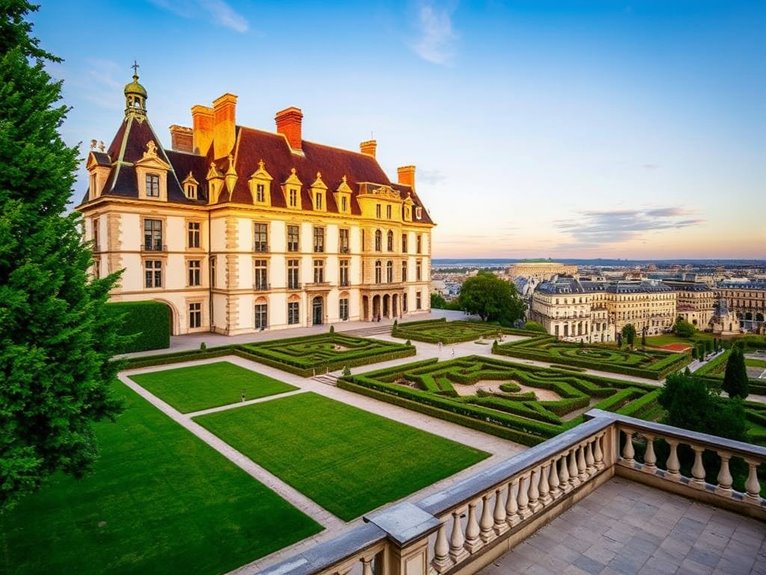
Just 20 kilometers west of Paris lies Saint-Germain-en-Laye, a sophisticated suburb that seamlessly blends medieval heritage with royal French history. This historic town, birthplace of Louis XIV and home to French kings since the Middle Ages, offers visitors a perfect escape from the bustle of Paris while providing an in-depth exploration of centuries of French culture and architecture.
The crown jewel of Saint-Germain-en-Laye is its magnificent château, now housing the National Archaeological Museum, surrounded by André Le Nôtre's meticulously designed gardens offering spectacular views over Paris. The charming town center, with its cobblestone streets, high-end boutiques, and excellent restaurants, creates an authentic French atmosphere that draws both history enthusiasts and casual visitors seeking a refined day trip experience.
Quick Facts:
- Best visiting time: Tuesday-Sunday, 10:00-17:00 (closed Mondays)
- Château entrance fee: €6 (free first Sunday of each month)
- RER A from Paris: 20-25 minutes (Zone 4)
- Photography: Allowed in château exterior and gardens; restricted in museum
- Weather consideration: Gardens best visited March-October
- Language: Basic French helpful but not essential
Major Attractions:
Château de Saint-Germain-en-Laye
This restored medieval castle houses France's National Archaeological Museum, featuring prehistoric to medieval artifacts. The château's Renaissance architecture and royal apartments offer visitors a glimpse into French royal life. Museum tours available in multiple languages.
Insider tip: Visit the castle's chapel, where Louis XIV was baptized, during morning hours when sunlight streams through the stained glass windows.
Le Nôtre Gardens
These perfectly manicured French formal gardens provide one of the Paris region's most spectacular terraces. The 2.4-kilometer terrace offers panoramic views extending to La Défense and the Eiffel Tower.
Insider tip: The gardens are free to access and particularly magical during sunset when fewer tourists are present.
Town Center
The pedestrian-friendly historic center features excellent patisseries, chocolatiers, and luxury boutiques. Don't miss the covered market (Les Halles) on Tuesday, Friday, and Sunday mornings.
Insider tip: Visit Pâtisserie Hardy, a historic establishment frequented by French presidents and celebrities for their famous macarons.
Pro Tips:
To maximize your visit, arrive early morning to explore the château when it's least crowded. Follow this with a stroll through the gardens before lunch in the town center. Many restaurants offer special lunch menus (formules) that provide excellent value. Consider visiting on market days to experience local life at its most vibrant.
Practical Advice:
Saint-Germain-en-Laye is accessible via RER A from central Paris (use your Navigo pass or purchase a Zone 4 ticket). The château and town center are a short walk from the station. Most attractions are closed on Mondays, and restaurants typically take their break between lunch and dinner service (usually 2:30-7:00 PM). Cash and major credit cards are widely accepted, but having some cash is recommended for market purchases and smaller shops.
Senlis: A Medieval Time Capsule in the Oise
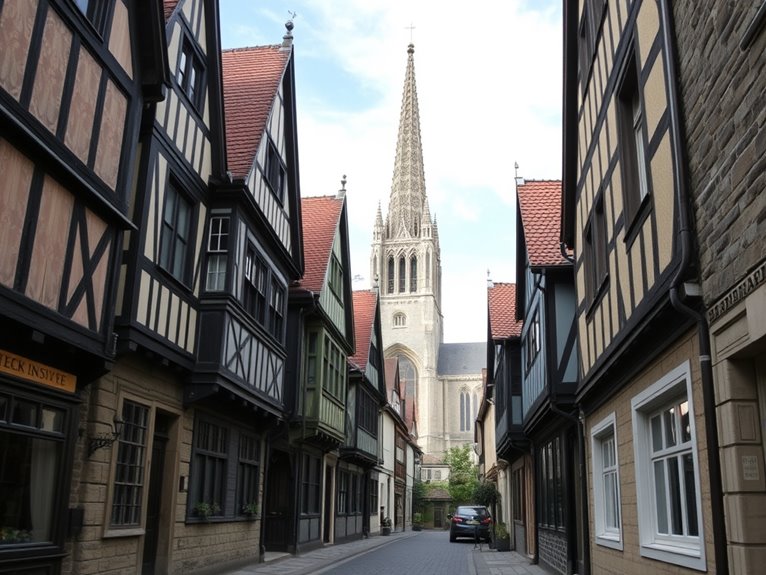
Just 45 kilometers north of Paris lies Senlis, a mesmerizing medieval town that seems frozen in time. With its cobblestone streets, preserved city walls, and a magnificent Gothic cathedral piercing the skyline, Senlis offers visitors an authentic glimpse into France's medieval past, unmarred by the overwhelming tourism found in other historic destinations.
Walking through Senlis feels like stepping into a living history book, where 2,000 years of French heritage unfolds before your eyes. From Roman ramparts to royal residences that hosted French monarchs, this compact town rewards visitors with architectural treasures, hidden gardens, and museums that chronicle its remarkable journey from a Gallo-Roman settlement to a prestigious royal city.
Quick Facts:
- Best visiting hours: 10:00 AM – 6:00 PM (most sites)
- Distance from Paris: 45 km (40 minutes by car, 1 hour by train)
- Cathedral visiting hours: 9:00 AM – 6:00 PM daily
- Photography: Permitted in most locations except museum interiors
- Ideal season: Spring and early fall
- Parking: Available at Place du Parvis and rue du Temple
- Tourist Office: Open Tuesday-Saturday, 10:00 AM – 5:30 PM
Cathédrale Notre-Dame de Senlis
The crown jewel of Senlis, this 12th-century Gothic cathedral boasts one of France's earliest Gothic portals and a 78-meter spire visible throughout town. Visit between 10:00 AM and 2:00 PM for ideal natural lighting through the stained glass windows. Insider tip: Look for the unique carved details on the western facade depicting the first sculptural representation of the Assumption of Mary in French religious architecture.
Medieval Ramparts
The ancient walls encircling Senlis stretch for 2.5 kilometers, with sixteen towers still standing. Access is free and open year-round. The best preserved section runs along Rue du Châtel. Lesser-known fact: Local residents maintain private gardens along certain sections of the walls, which bloom spectacularly in spring.
Musée d'Art et d'Archéologie
Housed in a former bishop's palace, this museum showcases Gallo-Roman artifacts and fine art from the region. Open Wednesday-Monday, 10:00 AM – 6:00 PM. Admission: €6. Secret highlight: The museum's basement contains perfectly preserved Roman foundations rarely mentioned in guidebooks.
Pro Tips:
Visit early on weekday mornings to have the medieval streets practically to yourself. Photographers should plan around the golden hour (just after sunrise or before sunset) when the honey-colored limestone buildings take on a magical glow. Consider visiting during the annual medieval festival in May when the town recreates its historic atmosphere with period costumes and demonstrations.
Practical Advice:
While Senlis is walkable, wear comfortable shoes as the cobblestone streets can be challenging. Many shops close between 12:30 PM and 2:30 PM for lunch, so plan accordingly. The tourist office offers excellent free maps highlighting themed walking routes. Most restaurants and shops accept credit cards, but carrying some cash is recommended for smaller purchases in traditional shops and cafes. Pre-book restaurant reservations on weekends, as dining options are limited and popular with both tourists and locals.
